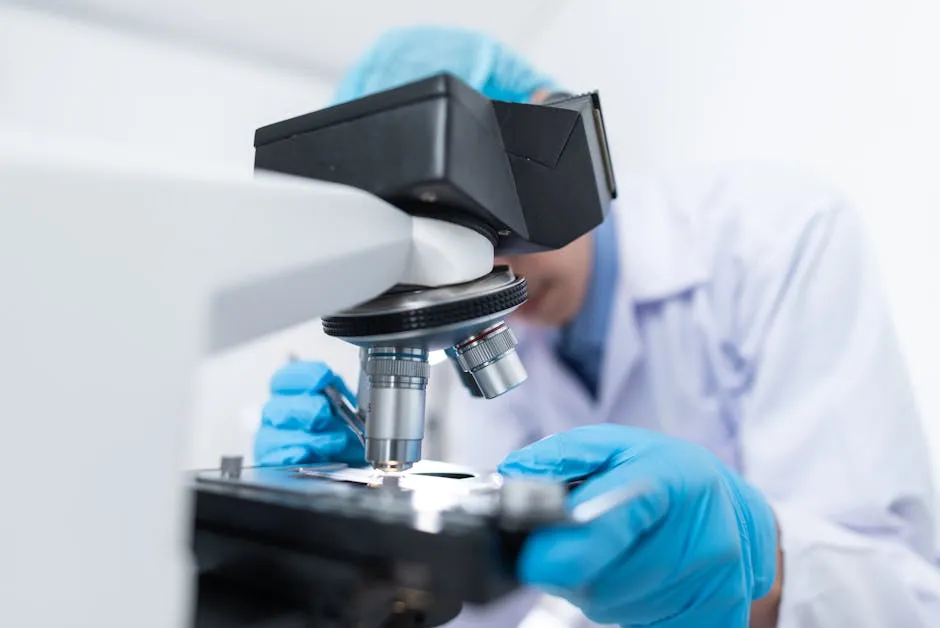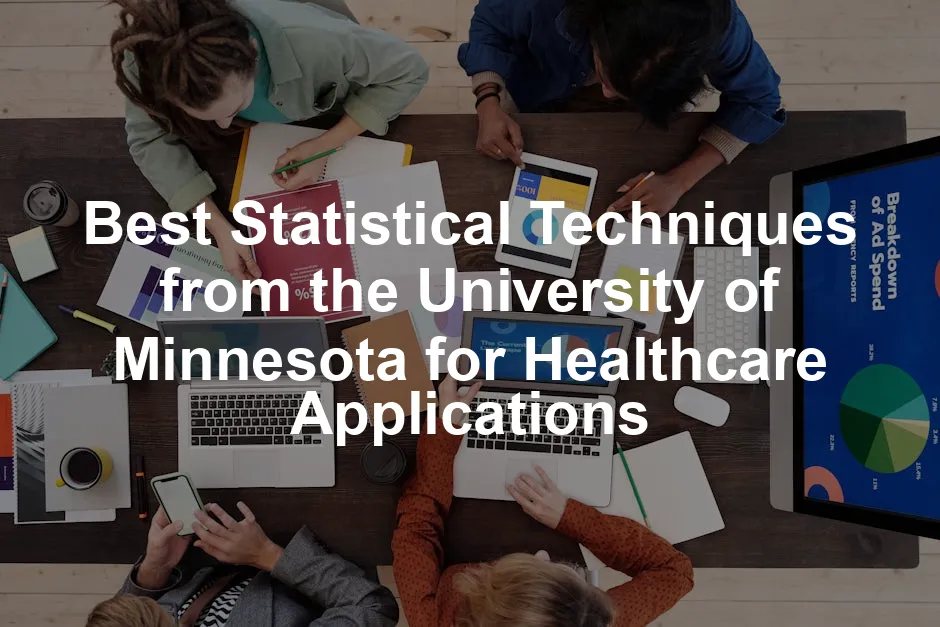Introduction
In today’s healthcare scene, statistical techniques are like superheroes in lab coats. They swoop in to save the day by making sense of the mountains of data generated daily. At the University of Minnesota, researchers are leading the charge, developing cutting-edge statistical methods that revolutionize healthcare applications. Whether it’s predictive modeling or Bayesian analysis, these techniques are invaluable for interpreting complex data and boosting patient outcomes.
Consider this: every time a patient walks into a clinic, a wealth of data is created. This includes everything from medical histories to treatment responses. But without the right statistical tools, this data can feel like a maze with no exit. Luckily, University of Minnesota researchers have made it their mission to navigate this maze and uncover meaningful insights.
Take Bayesian statistical learning methods, for example. These methods assign probabilities to various outcomes based on prior knowledge and new evidence. This powerful approach is crucial in identifying significant biomarkers in multi-omics data, which can include genomics, proteomics, and more. The complexity of these datasets requires sophisticated analysis—something that UMN excels at.
Moreover, the Innovative Methods & Data Science Program at UMN is a beacon of progress. Launched to tackle big data challenges in healthcare, it combines statistical rigor with computational prowess. This program is designed to support researchers and clinicians alike in translating data into actionable insights.
Throughout this article, we will highlight the best statistical techniques developed at the University of Minnesota. We’ll showcase real-world applications that demonstrate how these methods are enhancing healthcare and improving patient care. So, buckle up and prepare to see how statistical techniques are changing lives for the better!

Summary
The University of Minnesota is at the forefront of statistical innovation in healthcare. The techniques developed here are not just theoretical; they have practical applications that enhance patient care and research. This article will delve into several key areas of focus.
First up is Bayesian statistical learning methods. These methods are particularly effective for analyzing multi-omics data, which encompasses various biological layers. Researchers at UMN are using these methods to identify predictive pathways and clinically relevant subtypes of diseases like cancer and cardiovascular disorders. This approach allows for the discovery of biomarkers that can significantly impact treatment strategies.
Next, we’ll explore the Innovative Methods & Data Science (IMDS) Program. This initiative aims to develop novel computational methods that address the complexities of healthcare data. By integrating artificial intelligence and machine learning with statistical insights, UMN is paving the way for more accurate predictions and improved healthcare delivery.
Additionally, predictive modeling techniques are being refined at UMN. These models are essential for risk assessment and resource allocation in clinical settings. The ability to forecast patient outcomes can help healthcare providers make informed decisions, ultimately enhancing the quality of care.
Finally, expect insights into the role of multi-omics data in understanding complex diseases. By embracing a holistic view of biological systems, researchers are uncovering new avenues for treatment and prevention.
In conclusion, the statistical techniques pioneered at the University of Minnesota are not just advancing research; they are transforming healthcare practices. With a focus on real-world applications and innovative methods, UMN is committed to improving health outcomes. Keep reading to find out how these techniques are making a difference in the lives of patients.

The Role of Statistics in Healthcare
Understanding Healthcare Data
Imagine walking into a hospital where every heartbeat, breath, and lab result generates a mountain of data. That’s healthcare today! Statistical analysis plays a pivotal role in transforming this avalanche of information into actionable insights. It’s the magic wand that helps clinicians make sense of complex datasets, ensuring that patient care is informed by solid evidence rather than gut feelings.
Healthcare data comes in various forms. Clinical data includes patient records, lab results, and treatment outcomes. Administrative data comprises billing information, hospital admissions, and patient demographics. These datasets are essential for understanding health trends, evaluating treatment effectiveness, and improving overall patient care.
However, the sheer volume and complexity of this data can be daunting. With the rapid advancement of technology, healthcare providers often find themselves swimming in an ocean of information. The challenge lies in identifying significant patterns and relationships within this data. Without proper statistical techniques, crucial insights could easily go unnoticed, leading to less effective patient care and resource allocation.

Statistical Techniques Overview
So, what statistical techniques are we talking about? Picture this: regression analysis, hypothesis testing, and Bayesian methods. These tools are critical in healthcare research. They help identify relationships between variables, evaluate treatment efficacy, and make predictions about patient outcomes.
Rigorous data analysis is crucial for evidence-based decision-making. It provides healthcare professionals with the tools they need to interpret complex data, thereby facilitating informed decisions that can improve patient outcomes. In a world where data is king, understanding and utilizing these statistical techniques is essential for success in the healthcare field.
Next up, let’s dive into the key statistical techniques developed at the University of Minnesota. Trust me; it’s going to be enlightening!

Applications in Multi-Omics Data Analysis
Bayesian methods are the secret sauce in analyzing multi-omics data! They help researchers sift through layers of information—genomics, proteomics, and transcriptomics. At the University of Minnesota, these methods shine in understanding complex diseases.
How do they work? Bayesian methods assign probabilities based on past experiences and new evidence. This approach is crucial when dealing with the non-linear relationships often found in biological systems. For example, researchers can identify key predictive pathways and biomarkers that indicate disease progression. Think of it as connecting the dots in a complex puzzle.
Recent studies from UMN have showcased the power of these methods. One study focused on cancer and cardiovascular diseases, utilizing publicly available datasets like The Cancer Genome Atlas. By employing Bayesian predictive statistical models, researchers successfully selected features strongly associated with disease outcomes. These insights are invaluable for developing targeted therapies and improving patient care.

Innovative Computational Techniques
The Innovative Methods & Data Science Program
The Innovative Methods & Data Science (IMDS) program at UMN is a game-changer! Launched in November 2022, this initiative aims to develop novel computational and statistical techniques. Its goal? To analyze multimodal big data effectively and translate it into clinical insights.
The IMDS program focuses on creating accountable and interpretable methods for healthcare analytics. This means that researchers can derive meaningful insights while ensuring fairness and equity in their analyses. Moreover, IMDS partners with researchers to enhance AI and machine learning tools using statistical insights. This collaboration leads to more accurate predictions in healthcare settings, ultimately benefiting patients.
The program also offers expert consultation on modern study designs and data analytic methods. It’s like having a knowledgeable friend guiding you through the complex world of healthcare data! If you want to get a head start on this data revolution, consider checking out Machine Learning for Healthcare: A Comprehensive Guide. It’s a great resource for those looking to harness the power of data!

AI and Machine Learning Integration
Imagine combining the analytical power of statistics with cutting-edge AI and machine learning tools! At UMN, this integration is taking healthcare analytics to new heights. Researchers are leveraging statistical insights to inform AI models, making them more robust and effective.
For instance, clinical settings have witnessed successful applications of these combined methods. From predicting patient outcomes to optimizing treatment plans, the collaboration between AI and statistics is revolutionizing how healthcare is delivered. By using data-driven approaches, clinicians can make informed decisions that enhance patient care. Want to dive deeper? Check out Artificial Intelligence in Healthcare: A Comprehensive Guide for more insights!

Predictive Modeling and Risk Assessment
Importance of Predictive Analytics
Predictive modeling is like having a crystal ball in healthcare. It allows providers to foresee potential outcomes and make proactive decisions. This is crucial for improving patient care and resource allocation.
At the University of Minnesota, predictive analytics plays a central role in healthcare. Researchers are continuously refining models to enhance their accuracy and applicability. By analyzing vast datasets, they can identify risk factors and predict patient outcomes more reliably. This means that clinicians can intervene earlier, potentially saving lives! If you want to learn more about predictive analytics, consider checking out Predictive Analytics for Healthcare: How to Improve Patient Outcomes.
Through this approach, UMN is not only advancing research but also ensuring that healthcare providers are equipped with the tools they need to make informed decisions. Predictive analytics is an essential ingredient in the recipe for better healthcare outcomes!
Future Directions in Statistical Techniques for Healthcare
Emerging Trends
The world of healthcare statistics is buzzing with new trends. As we move forward, emerging statistical techniques are gaining traction. These methods enhance our ability to analyze complex data and improve patient care.
One key trend is the rise of machine learning algorithms. These algorithms can analyze massive datasets, identifying patterns that traditional methods might miss. Hospitals are using these insights to predict patient outcomes and optimize treatment plans. Imagine a scenario where a machine learning model can predict which patients are at risk for readmission. This capability allows healthcare providers to intervene early, potentially saving lives. Curious about the fundamentals of data science? Check out Data Science for Dummies for an easy introduction!
Another exciting development is the integration of artificial intelligence (AI) with statistical methods. AI enhances data analysis, providing deeper insights into patient data. For instance, researchers at the University of Minnesota are utilizing AI to refine predictive models for complex diseases. This combination of AI and statistics is paving the way for personalized medicine, tailoring treatments to individual patient needs.
Bayesian statistical methods are also on the rise. They offer flexibility in modeling complex relationships within healthcare data. By assigning probabilities to different outcomes, these methods improve the accuracy of predictions. As more researchers adopt Bayesian approaches, we can expect a significant leap in our understanding of disease mechanisms. Interested in diving deeper? Consider Bayesian Data Analysis for an insightful read!

Moreover, the focus on multi-omics data analysis is expanding. This approach integrates data from genomics, proteomics, and metabolomics, providing a comprehensive view of patient health. The University of Minnesota is leading the charge in this area, using innovative statistical techniques to uncover hidden insights from multi-omics datasets. This holistic view enables better identification of biomarkers and disease subtypes, ultimately improving patient care.
The Role of Ongoing Research
Continuous research is essential for advancing statistical techniques in healthcare. The collaboration between academia and healthcare providers is vital in this process. Universities, such as the University of Minnesota, are not only developing innovative methods but also translating them into clinical practice.
Ongoing research focuses on refining existing methods and creating new ones. For example, the Innovative Methods & Data Science (IMDS) program at UMN is at the forefront of this effort. This program brings together statisticians, data scientists, and healthcare professionals to develop robust analytical tools. Their goal is to ensure these tools are both effective and equitable, considering diverse patient populations.
Furthermore, partnerships with healthcare providers foster the application of these techniques in real-world settings. Researchers gather feedback from clinicians, ensuring that statistical methods align with their needs. This collaboration leads to the development of user-friendly tools that can be easily integrated into clinical workflows. If you’re interested in understanding more about statistical modeling, check out Statistical Methods in Healthcare: A Practical Approach.

Additionally, the emphasis on real-world evidence is growing. Researchers are increasingly using data from clinical trials and routine healthcare practices. By analyzing this data, they can assess the effectiveness of new treatments and interventions in diverse populations. This approach not only strengthens the evidence base but also enhances the applicability of statistical methods in everyday healthcare scenarios.
In summary, the future of statistical techniques in healthcare looks bright. With emerging trends and ongoing research, we are on the cusp of significant advancements. These innovations promise to enhance patient care, improve outcomes, and ultimately transform the healthcare landscape. The collaboration between academia and healthcare providers will continue to play a crucial role in this evolution, ensuring that statistical methods remain relevant and impactful.

Conclusion
The statistical techniques developed at the University of Minnesota are not just academic concepts; they are vital tools reshaping healthcare. From Bayesian methods to innovative computational techniques, these approaches offer unprecedented ways to analyze complex data and derive meaningful insights. These insights help identify key biomarkers and predictive pathways, ultimately leading to improved patient outcomes.
To understand more about the significance of these techniques, you can explore statistical techniques in business and economics.
Understanding statistical techniques is essential for applying them effectively in healthcare settings. Learn more about statistical techniques in business and economics.
The University of Minnesota stands out as a leader in bridging the gap between data science and clinical practice. Researchers relentlessly work to apply sophisticated statistical models to real-world healthcare challenges. Their efforts are crucial in tackling the vast amounts of multi-omics data generated from advanced medical technologies. By integrating these innovative methods, healthcare providers can make better-informed decisions that enhance patient care.
The significance of these techniques cannot be overstated. They empower healthcare professionals to utilize data more effectively, ensuring that clinical decisions are evidence-based. This transformation is not just about numbers; it’s about improving lives. As these techniques evolve, they will continue to play a pivotal role in shaping the future of healthcare.
Staying informed about advancements in this field is essential. Readers are encouraged to follow the latest research from the University of Minnesota and consider how they can contribute to these innovations. Whether you’re a healthcare professional, a data scientist, or simply a curious mind, there’s a place for you in this exciting journey. The intersection of healthcare and statistics is where the magic happens—let’s embrace it together!

FAQs
What are the key statistical techniques used in healthcare?
Healthcare relies on various statistical techniques to extract valuable insights. Common methods include regression analysis, which helps identify relationships between variables; Bayesian methods, allowing for probability-based predictions; and survival analysis, which examines time-to-event data. Each technique plays a vital role in understanding patient data and improving healthcare outcomes.
How does the University of Minnesota contribute to healthcare analytics?
The University of Minnesota is a powerhouse in healthcare analytics. Through initiatives like the Innovative Methods & Data Science (IMDS) program, it develops cutting-edge computational and statistical methods. This program partners with healthcare providers to ensure that research translates into effective clinical practices. Moreover, ongoing studies focus on multi-omics data analysis to understand complex diseases better.
What is the importance of multi-omics data in healthcare?
Multi-omics data integrates various biological data types, such as genomics, proteomics, and metabolomics. This integration provides a comprehensive view of disease mechanisms, allowing researchers to identify critical biomarkers and therapeutic targets. Understanding these connections enhances the ability to tailor treatments to individual patient profiles, ultimately leading to better health outcomes.
How can healthcare professionals utilize statistical techniques?
Healthcare professionals can apply statistical techniques in various ways. For instance, they can use regression analysis to assess treatment effectiveness or Bayesian methods for predicting patient outcomes. Additionally, understanding statistical principles helps clinicians critically evaluate research studies and make informed decisions based on evidence. Continuous education in statistics is highly beneficial for enhancing their analytical skills.
Where can I learn more about statistical techniques in healthcare?
For those interested in expanding their knowledge, the University of Minnesota offers various resources and courses. The Innovative Methods & Data Science program provides access to expert consultation and workshops. Additionally, online courses and certificates in healthcare analytics are available through institutions like Saint Mary’s University of Minnesota. Exploring these opportunities can pave the way for a career at the intersection of healthcare and data science.
Please let us know what you think about our content by leaving a comment down below!
Thank you for reading till here 🙂
All images from Pexels




